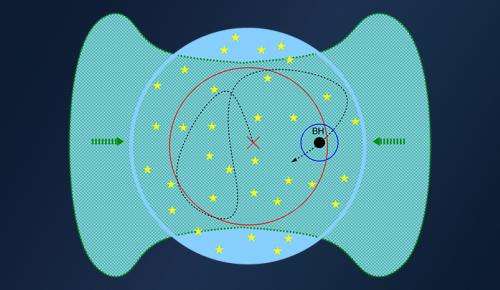August 8, 2014 report
Research duo suggest possible explanation for rapid growth of seed black holes in early universe

(Phys.org) —A pair of researchers, Tal Alexander of the Weizmann Institute of Science, in Israel and Priyamvada Natarajan with Yale University in the U.S. has come up with a possible explanation for the rapid growth of black holes believed to have existed in the early universe. In their paper published in the journal Science, the two propose that early black holes could have grown much more rapidly than those observed today due to dense gases that existed at the time that allowed for rapid growth in the absence of an accretion disk.
Black holes are thought to exist at the center of most if not all galaxies—but contrary to popular science fiction, they don't simply suck in everything around them like a vacuum cleaner—if that were the case planet Earth would have been sucked into the black hole at the center of the Milky Way long ago. Materials are pulled into a black hole, but are slowed by the buildup of an accretion disk. That disk means that materials can only be pulled in along the plane of the disk. There is also the problem of materials colliding as they are pulled closer, generating enough energetic radiation to push other material away from the black hole. While this all makes sense in the modern era, it causes problems for space scientists seeking to figure out how everything got to where it is now—most theories point to super-massive black holes forming shortly after the Big Bang. But, how did they grow so big so fast?
Alexander and Natarajan think they may have the answer—they note that shortly after the Big Bang, the universe was of course, much smaller and denser. Cold dense gas, they suggest, in the vicinity of a black hole would not have been susceptible to causing heat creation due to collisions. But perhaps more importantly, the gravity pull from other nearby stars could have caused black holes to move around in odd, erratic fashion, preventing the creation of an accretion disk. That in turn would mean material could be pulled into the black hole from every direction, greatly increasing the speed at which it would build in mass.
A model the two built based on their ideas, suggests such a scenario could lead to a black hole starting with ten times the mass of our modern sun, growing to something ten billion times as big in just a billion years.
More information: Rapid growth of seed black holes in the early universe by supra-exponential accretion, Science DOI: 10.1126/science.1251053
ABSTRACT
Mass accretion by black holes (BHs) is typically capped at the Eddington rate, when radiation's push balances gravity's pull. However, even exponential growth at the Eddington-limited e-folding time tE ~ few×0.01 Gyr, is too slow to grow stellar-mass BH seeds into the supermassive luminous quasars that are observed when the universe is 1 Gyr old. We propose a dynamical mechanism that can trigger supra-exponential accretion in the early universe, when a BH seed is trapped in a star cluster fed by the ubiquitous dense cold gas flows. The high gas opacity traps the accretion radiation, while the low-mass BH's random motions suppress the formation of a slowly draining accretion disk. Supra-exponential growth can thus explain the puzzling emergence of supermassive BHs that power luminous quasars so soon after the Big Bang.
Journal information: Science
© 2014 Phys.org





















